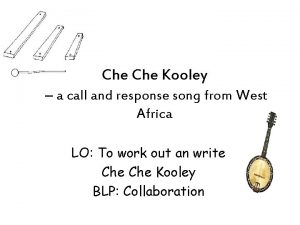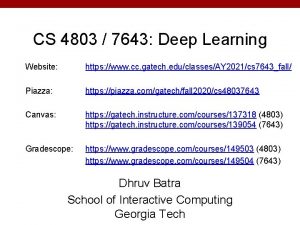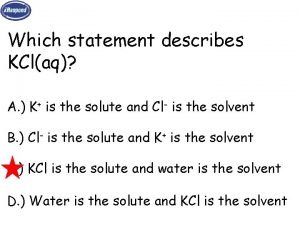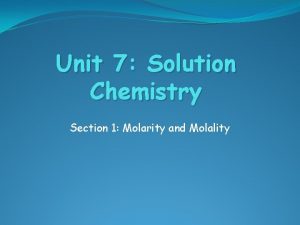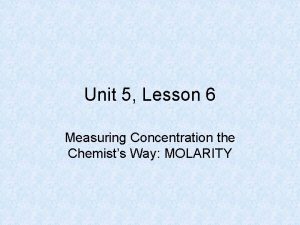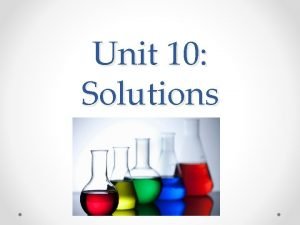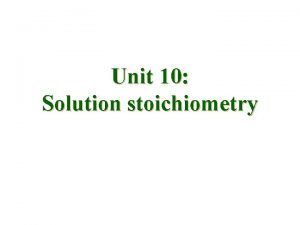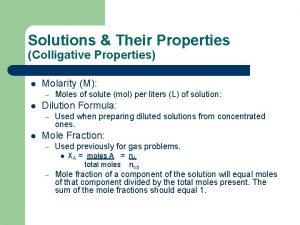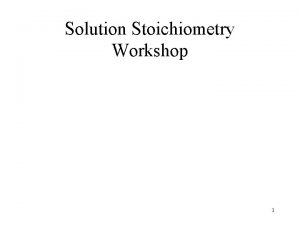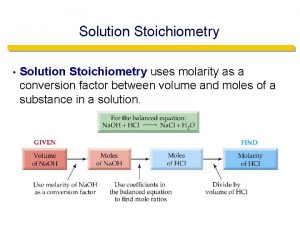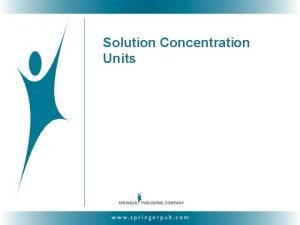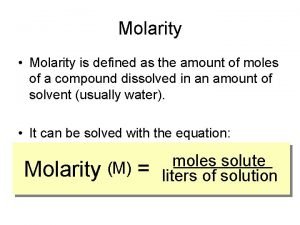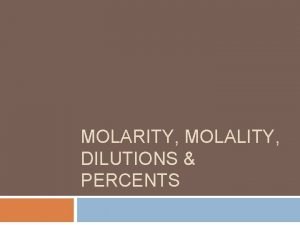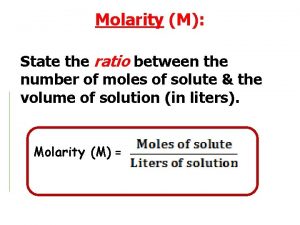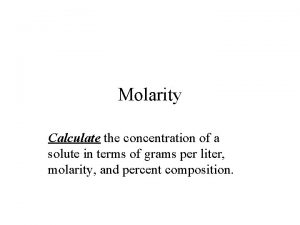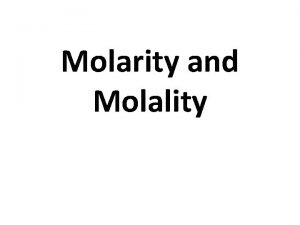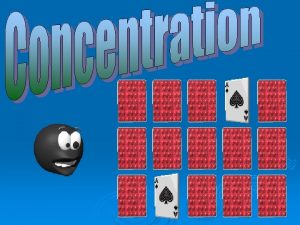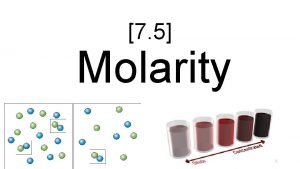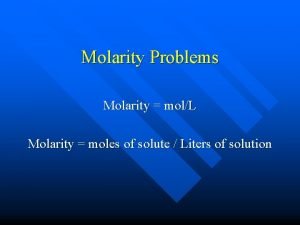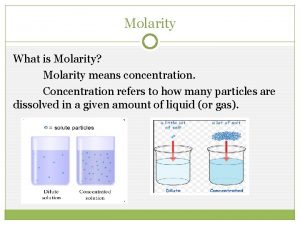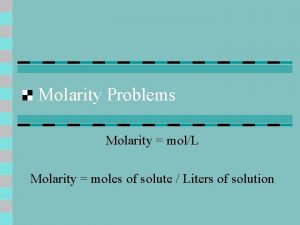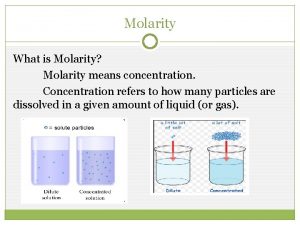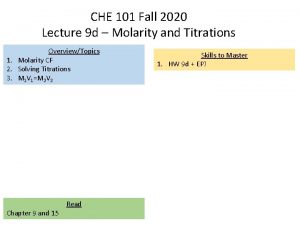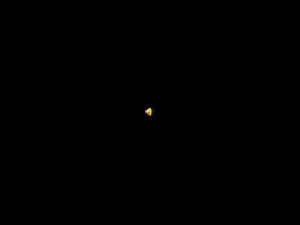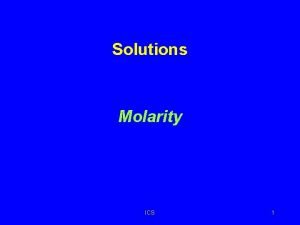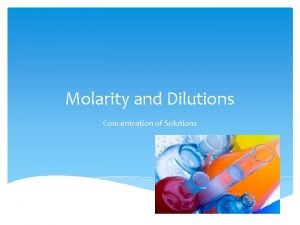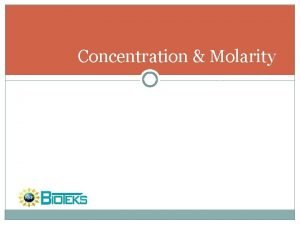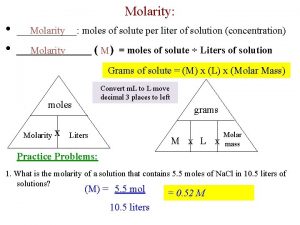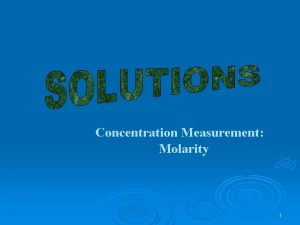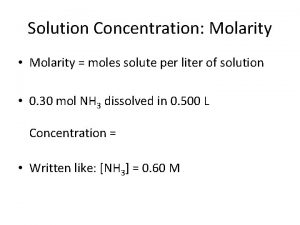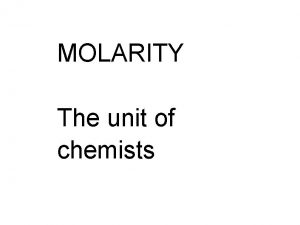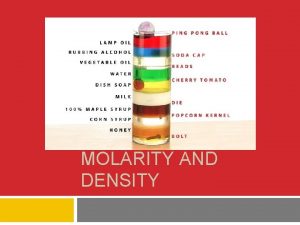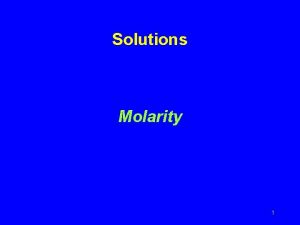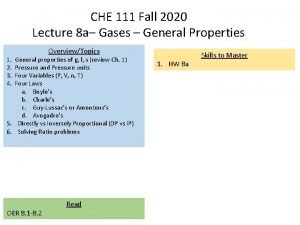CHE 111 Fall 2020 Lecture 7 h Molarity






























- Slides: 30

CHE 111 Fall 2020 Lecture 7 h – Molarity and Titrations Overview/Topics 1. Use of CF to Solve Problems a. MW b. M c. Mol/mol ratio d. Chemical Formula e. % Composition 2. Types of Problems a. Titration Problems b. Gravimetric Analysis c. Combustion Analysis OER 7. 5 Read Skills to Master 1. HW 7 h + EP!

Review 7 e Molarity (M or mol/L) o Equivalent of MW for aqueous solutions o CF between m. L and mols o Write M but in problems use mol/L MW Grams A MW mol/mol Mol A Mol B Mol to Mol Ratio from Balanced Eqn Molecular Weight g/mol M m. L A Grams B Molecular Weight g/mol M m. L B

Titration “Neutralization” Method to determine the concentration or amount of an unknown substance by reacting it with a known substance A+B→C+D Conc. (M) Vol. (V) Known Concentration Known Volume Indicator – Changes color when: [A] = [B] Unknown Concentration Known Volume or Mass Conc. (M) Vol. (V) Given any 3 value’s can solve for the missing value.

Example: _2_ H 3 PO 4 (aq) + _3_ Mg(OH)2 (aq) → _1_ Mg 3(PO 4)2 (aq) + _6_ H 2 O + Heat How many m. L of 4. 75 M H 3 PO 4 are required to titrate 107. 5 m. L of 3. 50 M Mg(OH)2?

Example: _1_ H 2 SO 4 (aq) + _2_ Na. OH (aq) → _1_ Na 2 SO 4 (aq) + _2_ H 2 O + Heat It required 250. 0 m. L of 5. 0 M Na. OH to neutralize 175. 0 m. L of an unknown concentration of H 2 SO 4. What is the Molarity of the H 2 SO 4 solution?

Tools for Solving Problems II A B m. L x ? M x x Start: m. L A m. L B MW Grams A 2 Types of Titration Problems A B m. L x x M x ? Start: MW mol/mol Mol A Mol B Mol to Mol Ratio from Balanced Eqn Molecular Weight g/mol M m. L A Grams B Molecular Weight g/mol M m. L B

You Try It: _1_ H 2 SO 4 (aq) + _2_ KOH (aq) → _1_ K 2 SO 4 (aq) + _2_ H 2 O + Heat It required 117. 0 m. L of 2. 50 M H 2 SO 4 to neutralize 15. 0 m. L of an unknown concentration of KOH. What is the Molarity of the KOH solution?

You Try It: _3_ HCl (aq) + _3_ Al(OH)3 (aq) → _1_ Al. Cl 3 (aq) + _3_ H 2 O + Heat How many m. L of 1. 25 M Al(OH)3 are required to titrate 95. 0 m. L of 0. 75 M HCl?

Percent Composition Problems Percent Composition Percent Pure/Impurity Mass Element × 100 Total Mass Substance Mass Pure Substance × 100 Total Mass Substance Mass Impure Substance Total Mass Substance × 100

Example: C 2 H 4 100. 00% Double Check

You Try It: C 6 H 12

Empirical vs Molecular Formula Empirical Formula Molecular Formula Smallest whole number ratio atoms MW Absolute number of each type of atom in a compound Ex: C 1 H 2 Ex: C 2 H 4 or C 6 H 12 Doesn’t Exist Actual MW Empirical MW = n (# of units/molecule) (Cx. Hy ) × n = Cnx. Bny Empirical Formula ×n= Molecular Formula

Example: The molecular weight of an unknown compound of Cx. Hy is 85. 15 g/mol. You determine the Empirical formula to be C 1 H 2. What is the correct Molecular formula? Step 1 Actual MW Empirical MW = n (# of units/molecule) (Cx. Hy ) × n = Cnx. Bny Step 2 Empirical Formula 85. 15 g/mol 14. 03 g/mol = 6. 07 ×n= Molecular Formula C 1 H 2 x 6 = C 6 H 12

Example: The molecular weight of an unknown compound of Cx. Hy is 142. 27 g/mol. You determine the Empirical formula to be C 5 H 11. What is the correct Molecular formula?

Gravimetric Analysis Method to determine the percent composition of a component of a compound by reacting it create a state change (generally to solid). Multiple applications allow the chemical formula to be determined. Examples: o Lab 8 – Water in Hydrates o Formation of PPT o Combustion Mass of Unknown Compound (A) A+B→C+D Original Sample PPT Mass (g) Reagent React with excess B to Form a PPT Mass (g) Mass of Known C PPT

Example: A 0. 750 g mixture of K 2 SO 4 + an unknown compound is reacted with excess Ba(NO 3)2 resulting in the precipitation of 0. 900 g of Ba. SO 4 (s). (a) What is the concentration (% K 2 SO 4) in the mixture? (b) What is the % of the impurity in the sample? _1_ Ba(NO 3)2 (aq) + _1_ K 2 SO 4 (aq) → _1_ Ba. SO 4 (s) + _2_ KNO 3 (aq) 174. 27 g/mol 233. 43 g/mol

You Try It! An impure sample of Al. Cl 3 that weighs 5. 00 grams is reacted with excess Ba(NO 3)2 resulting in the precipitation of 4. 50 g of Ba. Cl 2 (s). (a) What is the concentration of pure (% Al. Cl 3) in the mixture? (b) What is the % of the impurity in the sample? __ Ba(NO 3)2 (aq) + __ Al. Cl 3 (aq) → __ Ba. Cl 2 (s) + __ Al(NO 3)3 (aq) 133. 3 g/mol 208. 23 g/mol

Example: A 2. 50 g sample of Vx. Cly is reacted with excess Ba(NO 3)2 to produce 5. 40 g of Ba. Cl 2 (s) precipitate. (a) What is the % of V and % Cl in the sample? (b) What is the empirical formula of Vx. Cly compound? (c) What is the charge of the Vanadium cation? (Name the compound) V = 50. 94 g/mol Cl = 35. 45 g/mol Ba. Cl 2 = 208. 23 g/mol

You Try It! A 1. 66 g sample of Chromium (? ? ? ) Carbonate is reacted with excess Barium Nitrate to produce 4. 25 g of Barium Carbonate (s) precipitate. (a) What is the % of Chromium and % of Carbonate in the sample? (b) What is the empirical formula of the chromium carbonate compound? (c) What is the charge of the chromium cation? Cr = 52. 00 g/mol (CO 3) = 60. 00 g/mol Ba. CO 3 = 197. 34 g/mol Ba(NO 3)2 = 261. 35 g/mol

Combustion Analysis An unknown (generally hydrocarbon) is combusted and the resulting products massed. The % -composition or chemical formula of the original sample is determined Mass of CO 2 → Mass of C Mass of H 2 O → Mass of H Cx. Hy (l) + excess O 2 → x CO 2 (g) + y/2 H 2 O (g)

Example: 2. 50 grams of an unknown hydrocarbon Cx. Hy was burned to produce 7. 49 g of CO 2 (g) and 4. 09 g of H 2 O (g). (a) What is the % composition of the unknown hydrocarbon? (b) What is the empirical formula of the unknown hydrocarbon? CO 2 = 44. 01 g/mol H 2 O = 18. 02 g/mol

You Try It! 5. 00 grams of an unknown hydrocarbon Cx. Hy was burned to produce 16. 15 g of CO 2 (g) and 5. 29 g of H 2 O (g). (a) What is the % composition of the unknown hydrocarbon? (b) What is the empirical formula of the unknown hydrocarbon? CO 2 = 44. 01 g/mol H 2 O = 18. 02 g/mol

Review of Chemical Calculations Problem Lots of problem types, how are you going to remember it all? Solution 1. Learn to use the Road Map 2. Learn to use different conversion factors a. MW b. M c. mol/mol ratio d. Chemical formula e. % composition 3. List the different problem types

Road Map to Success A+B→C+D Use Reactants Make Products MW Grams A or R 1 + R 2 → P 1 + P 2 MW mol/mol Mol A Mol B Mol to Mol Ratio from Balanced Eqn Molecular Weight g/mol M m. L A Grams B Molecular Weight g/mol M m. L B

Lots of Conversion Factors + General Rules o To go from A to B must use mol/mol ratio o Never start with a CF (MW, M, mol/mol ratio) o When in doubt convert to mols Conversion Factors MW = M= Q 1 unit → 1 unit 2 unit → 2 unit Percent’s Mass Element × 100 Total Mass Substance mol/mol ratio = A#= or A Mass Pure Substance × 100 Total Mass Substance

Tools for Solving Problems III Information about 1 compound (7 f) I know grams R 1 how much of R 2 do I need or P 1 do I make? g R 1→ g R 2 or P 2 Molarity Problems (7 f) I know m. L or grams of R 1 Information about 2 compounds (7 g) I know grams R 1 and R 2 Same as MW problems or Chart Limiting Reactant Excess Reactant Theoretical Yield Percent Yield or ____ g A ____ g B ____ g C ____ g D Titration/Neutralization (7 h) I know m. L and/or M of R 1 and R 2 “Titrate or Neutralize” 2 Types Problems – Memorize?

Percent Composition/Chemical Formula (7 h) Key Words % composition Chemical formula Gravimetric Analysis Combustion Analysis Mass’s of parts of a compound Total mass of a compound g Product → g A and g B and g. A × 100 = % A g Total g. B × 100 = % B g Total

Limiting Reactant Problems Limiting Reactant: The reactant that you run out of first Zero left at end of the reaction g R 1 → mol P 1 → g P 1 g R 2 → mol P 1 → g P 1 Fewest grams of P 1 determines LR Grams of a Product or Theoretical Yield: Excess Reactant: The reactant that is left over g LR → mol ER → g ER used - Starting g ER Used g ER Left Over ER Percent Yield: g LR → mol P → g P made Energy Released: Energy is just like a normal product g LR → mol LR → k. J Energy Double Check: Mass at Start = Mass at the End g R 1 + g R 2 = g ER + g P 1 + g P 2

2 Types of Titration Problems A B m. L x ? M x x Start: m. L A m. L B MW Grams A A B m. L x x M x ? Start: MW mol/mol Mol A Mol B Mol to Mol Ratio from Balanced Eqn Molecular Weight g/mol M m. L A Grams B Molecular Weight g/mol M m. L B

 011 101 110
011 101 110 Classical mechanics
Classical mechanics 01:640:244 lecture notes - lecture 15: plat, idah, farad
01:640:244 lecture notes - lecture 15: plat, idah, farad Frasi con subordinate oggettive esplicite
Frasi con subordinate oggettive esplicite La vita che avrai non sarà mai distante dall'amore che dai
La vita che avrai non sarà mai distante dall'amore che dai Che che kooley
Che che kooley Facesti come quei che va di notte che porta il lume
Facesti come quei che va di notte che porta il lume Cs 7643 deep learning
Cs 7643 deep learning Cs61c fall 2020
Cs61c fall 2020 Cs61c fall 2020
Cs61c fall 2020 Which statement describes kcl (aq)
Which statement describes kcl (aq) Chemistry unit 7 molarity
Chemistry unit 7 molarity Measures of concentration molarity quiz
Measures of concentration molarity quiz Molarity unit
Molarity unit Molarity
Molarity Units for molarity
Units for molarity Molarity and molality are colligative properties.
Molarity and molality are colligative properties. Solution
Solution Solution stoichiometry
Solution stoichiometry Unit for concentration
Unit for concentration Mass percent to molarity
Mass percent to molarity Molar solubility
Molar solubility Ppb to molarity
Ppb to molarity Moles to grams
Moles to grams Moles practice problems
Moles practice problems Molarity is defined as the
Molarity is defined as the Molality triangle
Molality triangle Molarity ratio
Molarity ratio Molarity of solution
Molarity of solution Molarity to molality
Molarity to molality Measures of concentration molarity
Measures of concentration molarity





